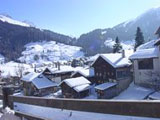Splügen
 Since the
late Middle Ages the transportation of goods over the Splügen pass[1]
was the main source of income for the population of Splügen even though their
alpine pass was in direct competition with the Gotthard pass. In 1473 Viamala was built, in 1643 and 1709
the pass routes particularly on the south side were repaired.
Since the
late Middle Ages the transportation of goods over the Splügen pass[1]
was the main source of income for the population of Splügen even though their
alpine pass was in direct competition with the Gotthard pass. In 1473 Viamala was built, in 1643 and 1709
the pass routes particularly on the south side were repaired.
In these centuries the population of Splügen had a good relationship with the Säumerei (tree planters), but different disasters ensured that the trees did not grow into the sky: 1716 and 1751 raged village fires, floods forced people to abandon endangered parts of the village and towards the end of the 18th century the French, who had penetrated through a division over Bernhardin, spread misery and fright.
The Rheinwalder however, are a tough and simple folk who always found the courage for new action. 1818 – 1823 the Splügen- and the Bernhardinstrasse were fully developed and both the goods and the transportation of people were in full bloom. The guest books of the hotels registered well over 1000 overnight stays per year. But with the opening of the Gotthard-Bahntunnels (Train tunnels) the work and earning ability of the Splügner was mostly destroyed. The transport of goods sank dramatically in a short period of time from 14000 tons down to 1000 tons. Many Splügner had to emigrate to North America or New Zealand. At the time of the 2nd World War the intention of letting the village Splügen sink in the flood waters of an artificial lake existed but was prevented through a small fight by the population. A new chapter in the long and moving history of the alpine pass village Splügen began in 1967 with the opening of the tunnel roads through Bernhardin. This new traffic route enabled Splügen to develop precipitously into winter sports and summer holiday destinations. Therefore, the value of agriculture lost none of its meaning; in fact the opposite occurred as tourism and agriculture function well next to each other.
Owing to its location at the foot of the Splügen passes which began with the Romans, the village served as a transit point for centuries. This diverse cultural mix settled in the architecture and in the nature of the inhabitants. The brown burned Walser houses, the proud Palazzi as well as the powerful Susten are witnesses and indication of this time, and therefore the village was classified by the Heimatschutz (Preservation of regional tradition) as “Ortsbild von nationaler Bedeutung” (Local picture of national importance). In 1995 Splügen received the “Wakkerpreis”[2]: An award which honours on the one hand, the protection of traditionally built structures, and on the other, the meaningful entwinement with present day times.
Text: Kurt Wanner
Resource: www.gemeinde-spluegen.ch
[1] The Splügen Pass (Italian Passo dello Spluga) connects on a height of 2'113 m the Swiss Hinterrhein valley in the canton of Graubünden with Chiavenna in the Italian province of Sondrio and the Lake Como. It is located at 46°30.36′N 9°20.22′E. The Pass constitutes the watershed between the Rhine and Po rivers.
[2] The Wakker Prize (in German: Wakkerpreis, in French Prix Wakker) is awarded annually by the Swiss Heritage Society to a Municipality of Switzerland for the development and preservation of its architectural heritage









